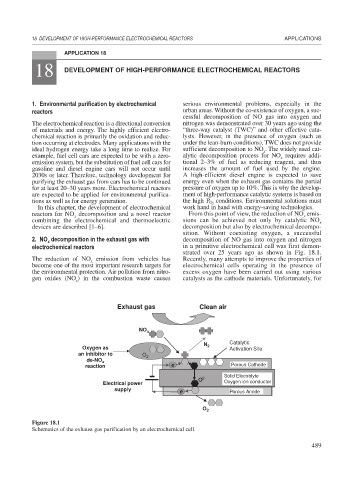Page 517 - Book Hosokawa Nanoparticle Technology Handbook
P. 517
18 DEVELOPMENT OF HIGH-PERFORMANCE ELECTROCHEMICAL REACTORS APPLICATIONS
APPLICATION 18
18 DEVELOPMENT OF HIGH-PERFORMANCE ELECTROCHEMICAL REACTORS
1. Environmental purification by electrochemical serious environmental problems, especially in the
reactors urban areas. Without the co-existence of oxygen, a suc-
cessful decomposition of NO gas into oxygen and
The electrochemical reaction is a directional conversion nitrogen was demonstrated over 30 years ago using the
of materials and energy. The highly efficient electro- “three-way catalyst (TWC)” and other effective cata-
chemical reaction is primarily the oxidation and reduc- lysts. However, in the presence of oxygen (such as
tion occurring at electrodes. Many applications with the under the lean-burn conditions), TWC does not provide
ideal hydrogen energy take a long time to realize. For sufficient decomposition to NO . The widely used cat-
x
example, fuel cell cars are expected to be with a zero- alytic decomposition process for NO requires addi-
x
emission system, but the substitution of fuel cell cars for tional 2–3% of fuel as reducing reagent, and thus
gasoline and diesel engine cars will not occur until increases the amount of fuel used by the engine.
2030s or later. Therefore, technology development for A high-efficient diesel engine is expected to save
purifying the exhaust gas from cars has to be continued energy even when the exhaust gas contains the partial
for at least 20–30 years more. Electrochemical reactors pressure of oxygen up to 10%. This is why the develop-
are expected to be applied for environmental purifica- ment of high-performance catalytic systems is based on
tions as well as for energy generation. the high P O 2 conditions. Environmental solutions must
In this chapter, the development of electrochemical work hand in hand with energy-saving technologies.
reactors for NO decomposition and a novel reactor From this point of view, the reduction of NO emis-
x
x
combining the electrochemical and thermoelectric sions can be achieved not only by catalytic NO x
devices are described [1–6]. decomposition but also by electrochemical decompo-
sition. Without coexisting oxygen, a successful
2. NO decomposition in the exhaust gas with decomposition of NO gas into oxygen and nitrogen
x
electrochemical reactors in a primitive electrochemical cell was first demon-
strated over 25 years ago as shown in Fig. 18.1.
The reduction of NO emission from vehicles has Recently, many attempts to improve the properties of
x
become one of the most important research targets for electrochemical cells operating in the presence of
the environmental protection. Air pollution from nitro- excess oxygen have been carried out using various
gen oxides (NO ) in the combustion waste causes catalysts as the cathode materials. Unfortunately, for
x
Exhaust gas Clean air
NO x
Catalytic
N
Oxygen as 2 Activation Site
an inhibitor to O 2
de-NO x
reaction e e e Porous Cathode
O 2- 2- Solid Electrolyte
O O
Electrical power Oxygen ion conductor
supply
e e e Porous Anode
O 2
Figure 18.1
Schematics of the exhaust gas purification by an electrochemical cell.
489

